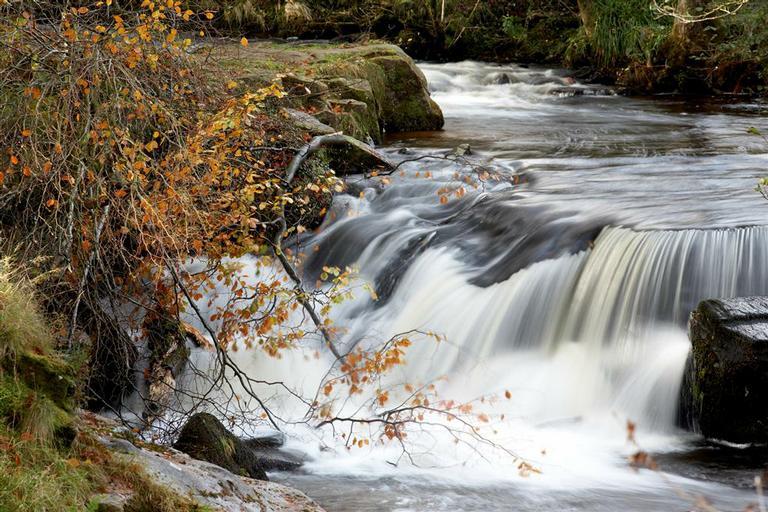How does it work?
Micro hydro, or small-scale hydro, is one of the most environmentally benign energy conversion options available, because unlike large-scale hydro power, it does not attempt to interfere significantly with river flows. Hydropower is a well-proven technology, relying on a non-polluting, renewable and indigenous resource, which can integrate easily with irrigation and water supply projects.
Hydro power works by using falling water to drive a turbine, which generates electricity. The amount of energy produced by a hydro power scheme depends on how far the water is falling (called head) and the flow rate (i.e. how much water is flowing past each second). Low-head sites are generally considered to be where the head is less than 3 metres. High-head sites, especially in the Bannau Brycheiniog, can have up to several hundred metres of head.
High Head Systems usually have a water intake above a weir or dam. Some of the water flowing along a watercourse is re-directed into the intake which screens for debris and fish to prevent them entering the turbine. From the intake the water then leads into a channel or pipe (called the penstock) where it falls down through one or more turbines. The water passing through the turbines generates electricity and is returned to the river afterwards. National Park Case Study:
Low Head Systems: One way to identify sites for small hydro power projects is to look for old water mill sites (or place names including the word “mill”). Usually the highest cost in Hydro power development is the building work needed to house the turbine appropriately and redirect water from the river through the turbine, and old mill sites may have some of the building work in place already. Although it is possible to use existing waterwheels to generate electricity it can be expensive and inefficient due to the gearing required to get the low revolutions per minute (rpm) of the waterwheel to the much higher rpm required by the electricity generator. National Park Case Study: Millbrook Mill.
What Permissions do I require?
Environmental criteria are very important in deciding whether a site is suitable for hydro power. The following permissions are usually needed to run a hydro power project:
-
Access permission to use the land.
-
Planning Permission from the National Park Authority.
-
Abstraction and Impoundment licenses from the Environment Agency.
The environmental impacts associated with construction and possible alterations to the river environment should be minimal for a micro hydro power project if the scheme is well designed. Nevertheless, sites should still be chosen carefully.
You will almost certainly require an abstraction and containment license for any hydro scheme. These licences are granted by the Environment Agency (EA). The EA recognises the potential benefits of small-scale hydropower to rural communities and in meeting local needs for power, but by their nature, hydropower proposals often require the EA to balance the requirements of developers with protection of the environment. Where a proposed scheme is inappropriate for its location the EA will advise a prospective developer at as early a stage as possible. It will take a positive view of reasonable and well designed proposals for hydropower schemes and will work with developers and others in attempting to agree a viable, sustainable project.
We advise that you follow three separate enquiries for your hydro system. First, ensure that you have a legal right to use the land. If you do not own the land ensure that you have written consent from a landowner and that your consent has been checked by a legal professional. Secondly you will require planning permission for your development. We advise that you consult with an accredited installer and develop detailed designs of the project before seeking planning permission. The National Park Authority Planning Department view hydro installations favourably, but they will require detailed drawings of your proposal. Thirdly, you will be required to contact the EA for your licenses to use the water. We recommend that you contact them first of all to ensure that they have no major concerns with your particular watercourse, but you will be required to have access and planning permissions already granted for the EA licences to be approved.
Costs and Maintenance: High head hydro systems have proved to be very reliable and can have a design life of 25 years or more. Costs vary due to a range of factors such as length of penstock, size of turbine and geographic location. Hydro systems generally require very little maintenance other than ensuring they are kept relatively clean and checking that the amount of flow in the watercourse is not at a low level (thus affecting your license to use the water).
Do I need Planning Permission? Please use the RELATED CONTENTS menu for more details on Planning Permissions.
Want to find a local installer? Please use the navigation menu to find a list of local, accredited (Low Carbon Buildings Programme) installers.
Grants: To find out what financial help may be available please use the RELATED CONTENTS menu.
For more information please telephone 01874 624437.
